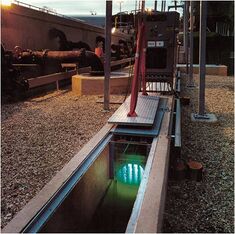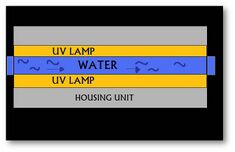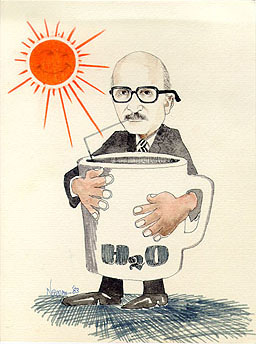Background

The content of this page comes from a presentation we gave to our engineering 308 class
at Humboldt State University. We are not claiming any data on this page as being ours,
we are only presenting information on a topic we have found interesting.
- Team
- Karl Ensminger, Nasley Proa, Tyler Ebright.
"Thousands have lived without love, not one without water" W.H.Auden
Using UV radiation to treat contaminated water started in Europe in the early 1900's. In 1904 the first UV quartz lamp was created. It's original purpose was to treat vitamin D deficiencies but later became a integral part of most current UV water treatment systems. These systems did not become available until 1981 and were not widely used until 1992. The most promising use of UV treatment is in developing countries where water borne illnesses are so prevalent. Several low cost and low maintenance systems have been created and are currently being used in villages in India and Africa providing safe water to some of the poorest communities. The biggest hurdle for the widespread use of these systems is that they need a power supply to operate. Each of these systems follows the same simple design:

Water flows into the housing unit around the UV low pressure mercury lamps maximum water depth is around 3 inches to insure the UV radiation can saturate the water to a high enough level that the bacteria and virus' within are neutralized. The water must be filtered before entering the UV treatment system as turbidity and dissolved solids in the water cuts down on the UV penetration into the water column.
The Science of UV treatment
How is UV radiation so effective at neutralizing bacteria and other micro-organisms? UV radiation is in the light spectrum below visible light and above x-rays. It has a wave length between 40-400nm. UVC 220-290nm is the portion of the UV spectrum used for anti bacterial purposes and has the ability to travel into the bodies of small organisms such as bacteria, viruses, yeasts and molds. The UV radiation attacks the DNA chain of these organisms causing them to loose their ability to reproduce effectively killing them. One down side to UV water treatment is that the deceased organisms will remain in the water without additional filtering to remove them.
Aftim Acra & SODIS

Aftim Acra is an active researcher and former professor of environmental engineering at the American University in Beirut. Acra and colleagues began research of solar water disinfection in 1979 and showed that the sun's heat and radiation is capable of killing pathogens. The sun supplies infrared radiation, which heats the water and can kill some bacteria, as well as ultraviolet radiation, which scrambles the DNA of the bacteria to disable their reproduction functions. Depending on the temperature and clearness of the sky, solar disinfection of water in a plastic bottle can take as little as six hours of direct sunlight. SODIS (solar water disinfection) is a strategy of disinfecting water promoted by the Swiss Federal Institute of Aquatic Sciences and Technology. The SODIS organization works to give people the opportunity and means to have clean water. They work primary in South America, Asia, and Africa where there are high concentrations of people living without adequate water and water systems. The disinfection method they advocate involves filling a transparent container with contaminated water.
One problem in this method is it's current reliance on plastic bottles. When the plastic these bottles are made from (Polyethylene terephthalate) react with the heat & UV radiation from the sun, chemicals in the plastic can be absorbed into the water. Another problem with the use of plastic bottles is the threads in the cap and spout of the bottle. This is one spot on the bottle that can not be disinfected by the sun because the cap is covering it! So if the bottle is used to scoop up water from a dirty source, and then disinfected with the SODIS method, the water will only be recontaminated by the threads of the bottle once poured out. It is important to keep in mind of any possible points of recontamination (i.e. dirty hands, dirty containers).
Below is a list of some of the bacteria ,virus', molds etc. that UV treatment can remove from water and the ultraviolet dosage required to destroy greater than 99.9% of micro-organisms. Measured in microwatt seconds per centimeter squared.
| BACTERIA | microwatt sec/cm2 |
|---|---|
|
Agrobacterium tumefaciens |
8500 |
| YEAST | microwatt sec/cm2 |
|
Bakers yeast |
8800 |
| MOLD SPORES | microwatt sec/cm2 |
|
Penicillum digitatum (olive) |
8800 |
| ALGAE | microwatt sec/cm2 |
|
Chlorella vulgaris (algae) |
22000 |
| VIRUSES | microwatt sec/cm2 |
|
Bacteriophage (E. coli) |
6600 |
UV Time Line
1900- UV radiation was used in some European countries to treat contaminated water.
1904- Heraeus, a medical company then, developed first UV quartz lamp in order to treat vitamin D deficiencies. That lamp developed into the tanning beds of today and into UV water treatment as well.
1976-UV water treatment was used in disinfection of aquatic systems in zoos and aquariums and in pools.It was also used in to disinfect potable and non potable water in ships.
1979- Sensors developed to monitor dose of UV to ensure a sufficient amount for disinfection.
Amalgam lamps developed; which use mercury bound with bismuth and indium2, instead of just liquid mercury.
1981- Wide acceptance of UV treatment for drinking water.
1992- UV disinfection in wastewater markets open up.
1997- Aquafine Corp., a leading designer and manufacturer of high quality industrial ultraviolet water treatment systems, has nearly tripled its growth over the past four years. International business accounts for 60 percent of that growth. Aquafine now designs, manufactures and installs state-of-the-art ultraviolet water treatment systems.
2000-American Water Works Association program that investigated effectiveness of UV systems on cryptosporidium. An outbreak in Milwaukee, Wisconsin occurred in the early 1990’s Chlorination alone did not offer sufficient protection against cryptosporidium, however, UV treatment does. Sales of UV drinking water disinfection systems in the USA increased.
2001-Combination systems are being developed, a mixture of chlorination, UV, membrane filtration, reverse osmosis and ozone oxidation.
2005- The current market for UV purification systems is 30% of the total market for drinking water treatment technologies; this number is expected to rise dramatically over the next few years due to several new strict standards the U.S. Environmental Protection Agency will finalize in 2006.
2006- New EPA regulations will require drinking water to be protected against cryptosporidium and other pathogens (which chlorine can’t do effectively) and to reduce disinfection by products commonly associated with chlorine and ozone treatments.
2009- For more than 60 years, UV light has been used effectively for disinfection and purification in water treatment plants. UV light technology also is used widely in hospitals, laboratories, food and drug facilities, and in a number of consumer products.
See also
External links
- http://www.epa.gov/ncer/sbir/success/pdf/innovative.pdf
- http://www.water-treatment.org.uk/water_treatment.html
- http://eetd.lbl.gov/IEP/archive/uv/UV_StatusRpt.html
- http://www.aquafineuv.com/UVTechnology/UVScience.aspx
- http://www.sciencedirect.com/science,
- http://www.cyber-nook.com/water/Solutions.html#uv,
- http://www.americanairandwater.com/uv-water-applications.htm,
- http://www.excelwater.com/eng/b2c/water_tech_3.php,
- http://www.aquatechnology.net/Ultraviolet_systems.html,
- http://www.me.washington.edu/academic/curriculum/water.php,
- http://www.waterworld.com/index/display/article-display/366837/s-articles/s-waterworld/s-volume-25/s-issue-8/s-editorial-feature/s-commissioning-uv-systems-case-study-of-three-drinking-water-treatment-plants.html,
- http://www.harvesth2o.com/uv.shtml,
- http://www.ultraviolet.com/microorgan.htm
- http://clpmag.org/article.php?article=Kenyans-Tap-Sun-to-Make-Dirty-Water-Sparkle_029
- Bourgoing, Robert. "Cleaning Water With Sunshine." International Development Research Centre Reports Apr. 1989: 21. http://idrinfo.idrc.ca/Archive/ReportsINTRA/pdfs/v18n2e/108893.pdf
- http://ddc.aub.edu.lb/projects/health/solar-water/acra.html
- Solar water disinfection
- Solar water treatment